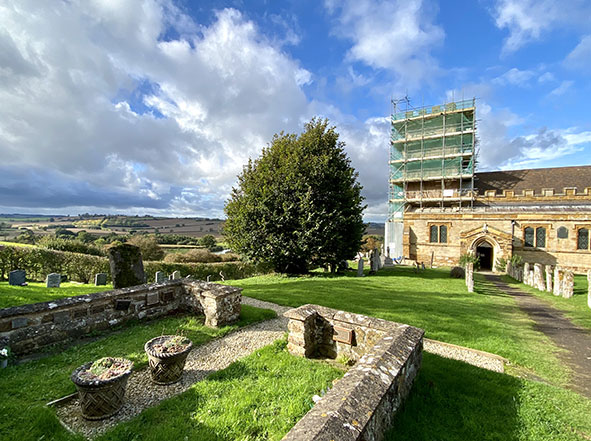Three Stories About Stowe Nine Churches
Posted 23rd November 2020
Nowhere does butterscotch-coloured stone-built villages quite like Northamptonshire. Two of my favourites are the twin hamlets of Upper Stowe and Church Stowe, known together as the parish of Stowe Nine Churches. Although they are set back from today’s hustle and bustle, their combined history encapsulates much of England’s history. I’ve chosen three great stories to share.
United by a network of field footpaths, the two settlements cling to the top of undulating hills, with long views over the countryside. Great visibility appealed to the Bronze Age inhabitants who constructed fortifications and ditches to the west, and the good grazing, fertile soil and plentiful water supply were essential supports for the ancient communities. Excitingly, recent research suggests that the area may have hosted the most important battle of the first millennium. In 2010, John Pegg argued that the locality is a strongly credible candidate for Boudicca’s last stand against the Roman invaders of Britain around AD 60. This battle decisively changed the governance of Britain from tribal rule to Roman control for the next 350 years. Tacitus, the Roman historian described the topographical details of the battlefield, and there is a close geographical match, seemingly stronger than that of other candidate locations. Remains on the ground have suggested that it is a real possibility. Early archaeologists discovered many interesting finds, pots, charcoal, and tools, along with substantial earthworks. Modern aerial surveys have revealed a military camp of a ‘playing card’ design typical of 1st Century Roman fortifications, showing internal buildings and external ditches. Whatever the truth of the matter, and we may never be certain, our present-day Stowe Nine Churches seems to have been an important Roman military site.
After the Roman control ended, Germanic tribes crossed over the North Sea to take advantage of the fertile lands and rich hunting grounds. Mixing together with the indigenous peoples, England as an entity began to evolve. And as Christianity arrived in the country, so devout Saxons wished to build churches to honour their God. The Lord of the Manor at Stowe endowed the hamlet with a single church, we don’t know exactly when, but the tower and doorway suggest an early Saxon date. But not nine churches, despite the name of the village! There has been much speculation as to where the name comes from, with the most popular being that the villagers tried to lay out the foundations for the church eight times. Each time the villagers discovered the next morning that their work had vanished or been thrown down. A labourer kept vigil overnight, and reported that the devil had sent a boggart to prevent the church from being built, as it was on a fairy ring. So the villagers changed to its current site, and the church was finally completed on the ninth attempt. I see no reason why this should not be true, although there are other less exciting explanations offered.
The Church of St Michael has a spectacular location set high overlooking a valley, and it is currently being restored with completion due in 2021. It is fortunate in having a most beautiful tomb, one of the finest ever created by Nicholas Stone, the most important English sculptor of the early 17th century. It commemorates Lady Elizabeth Carey, and is unusual for the time as it is a lifelike portrayal of her as an elderly lady, still beautiful but clearly not to be trifled with. She was born Elizabeth Neville, and married four times. One of her sons conspired with the Earl of Essex against Queen Elizabeth I, and was beheaded for his treachery. She died as the wife of Sir Edmund Carey, cousin to Queen Elizabeth, interestingly his Grandma was Mary Boleyn,
so his Great Aunt was Anne Boleyn. Lady Carey’s memorial was erected ten years before she died, and it was considered a masterpiece of the age. It is well worth a visit, along with other magnificent memorials.
Fast forward to more modern times, to the dark days before the Second World War. It became clear that the threat from the air was real. On 26th February 1935, a van was parked by a field on the edge of the parish of Stowe Nine Churches. It was filled with top secret equipment connected to improvised radio antennae located in the adjacent field. Hi-frequency radio waves were beamed from the local BBC Daventry transmitter, and when a Handley Page Heyford Biplane bomber flew overhead, the scientists were able to demonstrate that radio waves reflected off flying aircraft. Although the range was initially only eight miles, within five years this had developed to one hundred miles. Ultimately this led to the Royal Air Force prevailing during the Battle of Britain, and victory for the Allies. The location of the ‘Daventry Experiment’ is marked with a stone by the side of the Litchborough Road.
I’m sure that Boudicca would be proud to see the success of her fellow country folk to defend her country nearly two thousand years after her honourable defeat. And I also wonder if Boudicca enjoyed a little shopping! One of my favourite Northamptonshire retail destinations is to be found at the Stowe Old Dairy Farm Craft Centre. There are opportunities to buy original art works, model railway equipment, art blacksmith creations, woodturning, home fragrances, and textiles and lots more. All sorts of lovely things are for sale, and there is an excellent café serving snacks and meals in the old barn. Perfect for a socially distanced Christmas shopping trip, and to feel a connection with history in our wonderful county of Northamptonshire.
For more information please visit www.stoweninechurches.org.uk and www.olddairyfarmcentre.webeden.co.uk
